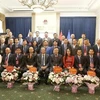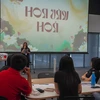A summer day in 2000 and Ho Van Lai, aged 10, and three other friends were playing a game on a quiet sandy beach near their home in Cua Viet town in the central province of Quang Tri . But, a minute later a huge bang cut the children’s game short.
The noise was the sound of an unexploded landmine going off, after being hidden silently underneath the beach for years after the American war in Vietnam .
Lai lost both his legs and his right arm as well as his right eye and had so many other severe wounds that he now depends on his parents help for virtually everything. That day, Lai, however, was luckier than two of his playmates as they died immediately in the explosion.
Four years after the accident, Lai was able to return to school to resume his studies. Now, aged 20 and a 10 th grade student, he has taken an active part in raising local people’s awareness of the danger of landmines.
As only one of thousands of survivors that bear the legacy of landmines and unexploded ordnance (UXO) left over from the war, Lai told his story in a talk show which was broadcast live on VTC14 and several other TV channels on April 4, which marks International Mine Awareness and Assistance Day as declared by the UN General Assembly on December 2005.
Although not a direct victim of landmines, La Thi Tam, the People’s Armed Forces Hero, was also on the talk show, recalling her assignment of recording the numbers of landmines and UXO left during the war to show how dangerous these weapons are.
In the 1967-68 period, Tam was posted at the Dong Loc T-junction in the central province of Ha Tinh with the job of counting the number of unexploded landmines, bombs and UXO dropped by US aircraft and then marking their positions on the ground for sappers to defuse them.
For nearly 200 days and nights on one of the fiercest battlefields of the war, Tam said she marked as many as 1,205 unexploded bombs. However, she admitted that she could not record the full number of all the mines and UXO dropped on the area she was responsible for.
Tam’s figures became even more significant when Major General Duong Duc Hoa, Commander of the Corps of Engineers, which is in charge of clearing UXO, explained that the US dropped up to 15 million tonnes of bombs, mines and explosives on Vietnam during the war, 800,000 tonnes of which are believed to remain unexploded.
He cited the preliminary results of a survey conducted in 2001 saying that up to 6.6 million hectares of land, or 20.12 percent of the country’s land mass and 90 percent of all landmine-contaminated communes nationwide, still contain UXO.
Even now the war has finished, bombs and mines are still taking a heavy toll on human life. To date, over 100,000 people in Vietnam have fallen victim to UXO and landmines, of which 42,000 have died.
In Quang Tri province alone, one in every five persons has fallen victim to landmines and UXO, a higher rate than in other countries that are also contaminated with bombs and mines, said Major General Hoa.
To address the landmine issue and support landmine victims, many areas and districts have worked out their own action plans and integrated them into the national plan, but much remains to be done.
“Even with investment and a lot of effort put in over the past 35 years, just 9-12 percent of landmine-contaminated land has now been cleared,” stated the Major General.
“However, it will take us hundreds of years and require us to spend dozens of billions of USD to clear all the unexploded bombs and landmines that lie undiscovered in the country,” the official emphasised.
To tackle the root cause of the landmine issue, Christophe Bahuet, the UNDP’s Vice Director in Vietnam, said that the country needs to urgently put together a national action plan to deal with the aftermath of landmines, work out a national coordinating mechanism and an action plan for the longer term, from between 5-10 years, as well as introducing action plans alongside socio-economic development plans, both on a local and central scale.
The fight against the landmines still scattered over many parts of the country was being given due attention by the State, the talk show heard.
Also present at the event was the Deputy Minister of Labour, War Invalids and Social Affairs, who revealed that his ministry has completed the gathering of opinions for a draft national action plan on overcoming UXO which will soon be submitted to the Prime Minister for approval.
The draft action plan sets out specific tasks, and includes producing a map that identifies the location of known areas infested with UXO, establishing a national database on landmine concentrations and casualties, introducing an educational programme to provide guide to people on how to avoid landmine accidents and outlining programmes to support the survivors of landmine detonations.
During the talk show, Vice State President Nguyen Thi Doan presented a scholarship worth 5 million VND to Ho Van Lai. As many as 550 wheel-chairs and 80 million VND were also donated to landmine victims while the talk shows organising board presented 50 boxes of gifts to victims in the central provinces of Ha Tinh and Quang Tri.
Along with Vietnam , more than 70 other countries around the world are also affected to some extent by landmines and UXO./.
The noise was the sound of an unexploded landmine going off, after being hidden silently underneath the beach for years after the American war in Vietnam .
Lai lost both his legs and his right arm as well as his right eye and had so many other severe wounds that he now depends on his parents help for virtually everything. That day, Lai, however, was luckier than two of his playmates as they died immediately in the explosion.
Four years after the accident, Lai was able to return to school to resume his studies. Now, aged 20 and a 10 th grade student, he has taken an active part in raising local people’s awareness of the danger of landmines.
As only one of thousands of survivors that bear the legacy of landmines and unexploded ordnance (UXO) left over from the war, Lai told his story in a talk show which was broadcast live on VTC14 and several other TV channels on April 4, which marks International Mine Awareness and Assistance Day as declared by the UN General Assembly on December 2005.
Although not a direct victim of landmines, La Thi Tam, the People’s Armed Forces Hero, was also on the talk show, recalling her assignment of recording the numbers of landmines and UXO left during the war to show how dangerous these weapons are.
In the 1967-68 period, Tam was posted at the Dong Loc T-junction in the central province of Ha Tinh with the job of counting the number of unexploded landmines, bombs and UXO dropped by US aircraft and then marking their positions on the ground for sappers to defuse them.
For nearly 200 days and nights on one of the fiercest battlefields of the war, Tam said she marked as many as 1,205 unexploded bombs. However, she admitted that she could not record the full number of all the mines and UXO dropped on the area she was responsible for.
Tam’s figures became even more significant when Major General Duong Duc Hoa, Commander of the Corps of Engineers, which is in charge of clearing UXO, explained that the US dropped up to 15 million tonnes of bombs, mines and explosives on Vietnam during the war, 800,000 tonnes of which are believed to remain unexploded.
He cited the preliminary results of a survey conducted in 2001 saying that up to 6.6 million hectares of land, or 20.12 percent of the country’s land mass and 90 percent of all landmine-contaminated communes nationwide, still contain UXO.
Even now the war has finished, bombs and mines are still taking a heavy toll on human life. To date, over 100,000 people in Vietnam have fallen victim to UXO and landmines, of which 42,000 have died.
In Quang Tri province alone, one in every five persons has fallen victim to landmines and UXO, a higher rate than in other countries that are also contaminated with bombs and mines, said Major General Hoa.
To address the landmine issue and support landmine victims, many areas and districts have worked out their own action plans and integrated them into the national plan, but much remains to be done.
“Even with investment and a lot of effort put in over the past 35 years, just 9-12 percent of landmine-contaminated land has now been cleared,” stated the Major General.
“However, it will take us hundreds of years and require us to spend dozens of billions of USD to clear all the unexploded bombs and landmines that lie undiscovered in the country,” the official emphasised.
To tackle the root cause of the landmine issue, Christophe Bahuet, the UNDP’s Vice Director in Vietnam, said that the country needs to urgently put together a national action plan to deal with the aftermath of landmines, work out a national coordinating mechanism and an action plan for the longer term, from between 5-10 years, as well as introducing action plans alongside socio-economic development plans, both on a local and central scale.
The fight against the landmines still scattered over many parts of the country was being given due attention by the State, the talk show heard.
Also present at the event was the Deputy Minister of Labour, War Invalids and Social Affairs, who revealed that his ministry has completed the gathering of opinions for a draft national action plan on overcoming UXO which will soon be submitted to the Prime Minister for approval.
The draft action plan sets out specific tasks, and includes producing a map that identifies the location of known areas infested with UXO, establishing a national database on landmine concentrations and casualties, introducing an educational programme to provide guide to people on how to avoid landmine accidents and outlining programmes to support the survivors of landmine detonations.
During the talk show, Vice State President Nguyen Thi Doan presented a scholarship worth 5 million VND to Ho Van Lai. As many as 550 wheel-chairs and 80 million VND were also donated to landmine victims while the talk shows organising board presented 50 boxes of gifts to victims in the central provinces of Ha Tinh and Quang Tri.
Along with Vietnam , more than 70 other countries around the world are also affected to some extent by landmines and UXO./.



















